The variations listed here have had different names or spellings assigned to them at various points. The sources for each are shown, in an effort to determine which name should be used for each variation. If anyone has any further Ringing World references or other information, which might aid this debate, please send it to .
Index
Salwarpe, Wollaston and Windrush
These were originally described in a letter from Paul Cattermole in 1961 (p. 255), referring to a peal at Wychbold (p. 248):
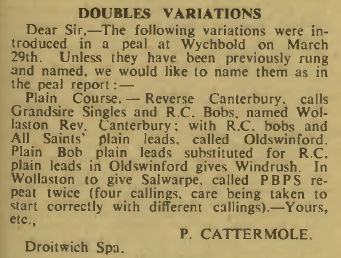
I read this as follows:
| Plain Course | Bobs | Singles | Name | Code |
|---|---|---|---|---|
| Reverse Canterbury | Reverse Canterbury | Grandsire | Wollaston | 131a/c |
| Reverse Canterbury | Reverse Canterbury | All Saints Plain | Oldswinford | 131a/f |
| Plain Bob | Reverse Canterbury | All Saints Plain | Windrush | 1a/f |
| Plain Bob | Reverse Canterbury | Grandsire | Salwarpe | 1a/c |
And the correction in 1962 (p. 791) to the attempted re-naming of two of the variations, as Ascension and St Stephen's, supports this reading.

![]()
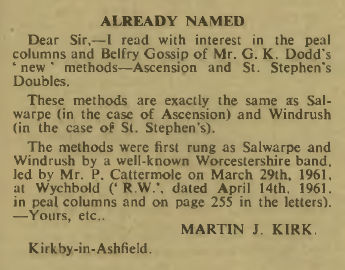
However, the Dodd-Jones collection (RW 1964 p. 514) appears to have confused Salwarpe (given as 131a/c), Wollaston (1a/f) and Windrush (1a/c), although Oldswinford is correct (but mis-spelled in Hiller). In fact Windrush is even used as an example on that page. And so these names have been used in many performances since, right up to the present.


1u/h - Plain Bob with a Grandsire Bob and a Pink's Single
This is given in Hiller as Senacre Wood, but I can't find when this name originates; the earliest use I've seen is in a peal at Compton Dando in 1979 (RW p. 433).
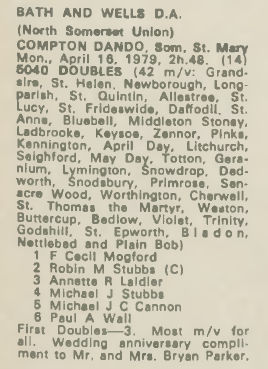
However, the other similar variations using a Pink's Single (1w/h, 1x/h and 1y/h) are all given in the Dodd-Jones collection (RW 1966 p. 183) and one would have expected 1u/h to have also been named.
A possible clue comes with a peal at Bronllys in 1967 (RW p. 558), in which it states that Pennywell had been given incorrectly in the Dodd-Jones collection in 1966.
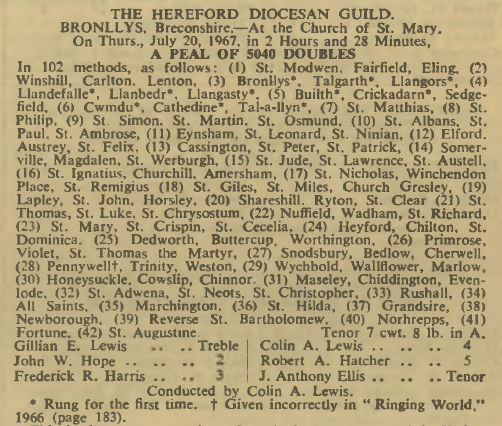
In the peal the grouping of variations in successive extents gives a pattern, which uses Grandsire Bobs, Wallflower Bobs and Antelope Bobs in each extent, with a different Single for each extent; Grandsire Singles, Wallflower Singles (All Saints Plains), Antelope Singles and Pink's Singles, respectively.
In extent (25), Dedworth, Buttercup and Worthington are 1u/c, 1w/c and 1x/c;
in extent (26), Primrose, Violet and St. Thomas the Martyr are 1u/f, 1w/f
and 1x/f;
in extent (27), Snodsbury, Bedlow and Cherwell are 1u/g, 1w/g and 1x/g;
and in extent (28), Trinity and Weston are 1w/h and 1x/h, which suggests Pennywell
is 1u/h.
Pennywell is given in the Dodd-Jones collection (RW 1966 p. 183) as Plain Bob with a Pink's Single and a Grandsire Single, which could indeed be an error for 1u/h.
![]()
This variation was also rung in a quarter peal at Ledbury in 1968 (RW p. 414), but the letter (p. 402) asking whether the variation (referred to as E) had been named got a dismissive answer (p. 443).
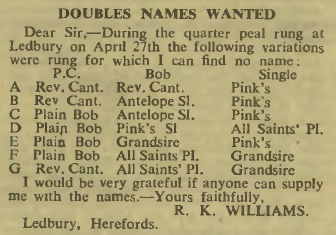
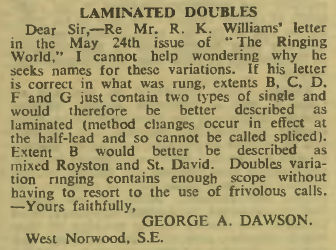
Since then, Pennywell was used in a peal at Cardigan (RW 1974 p. 74), where it is paired with St Clements (1u/g) and a peal at Wenhaston (RW 1987 p. 338), where it follows an extent of Dedworth (1u/c). Both of these point to Pennywell being 1u/h, not 1h/c.
So should 1u/h be known as Pennywell? And, in that case, what name does 1h/c then have?
Update: The 1968 quarter peal at Ledbury is now on BellBoard, including names of the variations rung. So, also, is another quarter peal at Ledbury, rung on 14th January 1968 (RW p. 92), which includes both Senacre Wood and Pennywell.
Lily and Rose
1 w/c/e - Plain Bob with a Wallflower Bob, Grandsire Single and Grandsire
Extreme
131 w/c/e - Reverse Canterbury with a Wallflower Bob, Grandsire Single and
Grandsire Extreme
These are named in the Dodd-Jones collection (RW 1964 p. 530), albeit in Section D, which contains variations about which there was some doubt.

They are given in the Hiller collection as Stow and Royal Oak, respectively. These names appear to originate in a peal at Broadwell in 1974 (RW p. 328), as Melvyn Hiller enquires about the names in the peal in a letter on page 387.
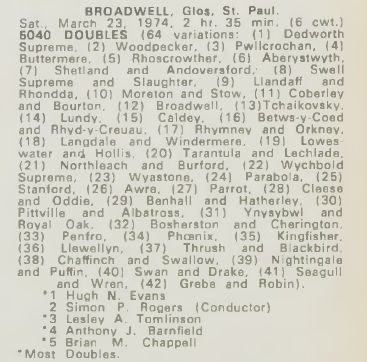
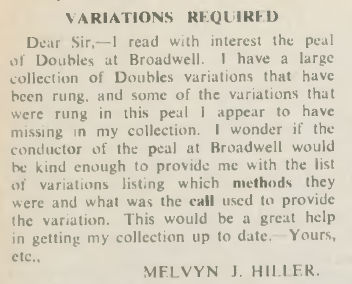
I haven't seen a reply published, but there may have been some private communication. The names of several other variations also appear for the first time in this peal.
Thrush, Blackbird and Robin
103e - Blackburn Place with a Grandsire Extreme
106e - Westminster II Bob with a Grandsire Extreme
112e - St Hilary Bob with a Grandsire Extreme
These were named in a peal at Staunton-on-Wye in 1967 (RW pp. 602 and 607), although the peal was later withdrawn due to a false extent (p. 714).
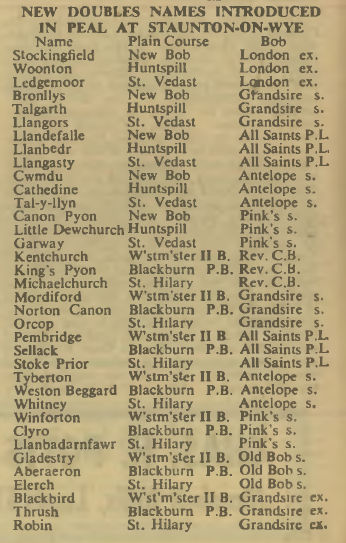
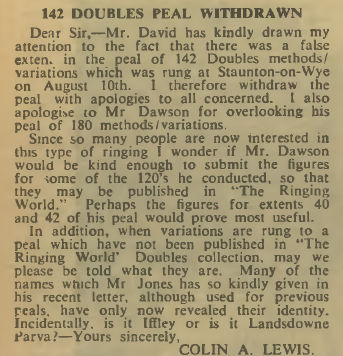
What was the requirement for naming a variation in 1967? Did it have to be in a peal? Did the falseness of one extent invalidate the others? However, Stockingfield (73dc), Woonton (69dc) and Ledgemoor (80dc) were also named in that peal, but their names appear to have stood.
The variations were later named as Newhall, Zeals and Mercaston, respectively, in quarter peals at Church Gresley in 1984 and 1986.
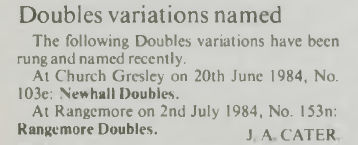
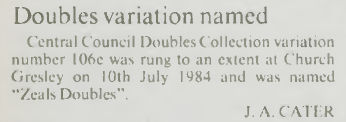
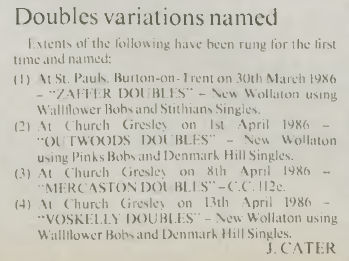
Brathay and Little Wyrley
69cd - Huntspill Bob with a Thurlby Single
80cd - St Vedast Bob with a Thurlby Single
69cd was rung at Wootton Courtenay in 1968 and named Little Wyrley (RW pp. 839 and 851). NB the numbers in front of each variation in the list below are references to the list published in the Ringing World (1968, pp. 575 and 595).
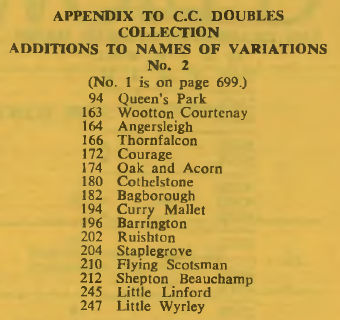
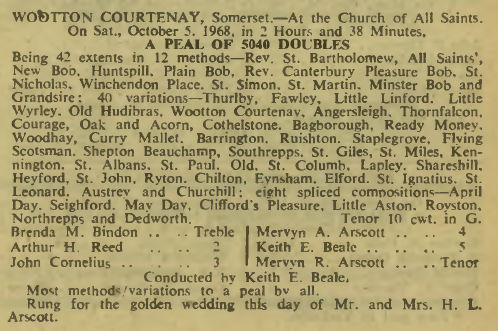
But Hiller had 69cd as Brathay and 80cd as Little Wyrley. I haven't found any reference to the naming of Brathay - nor references for some other Lake District names; Chapel Stile (78cd) and Skelwith Bridge (78dc).
Eling
80j - St Vedast Bob with a Plain Bob Plain
80je - St Vedast with an Old Hudibras Single
This variation is given in the Ringing World in 1964 (pp. 616 and 648) and listed in the Dodd-Jones collection (RW 1966 p. 215) as Eling. It was stated in 1964 that it was also known as Minster and St Britius.
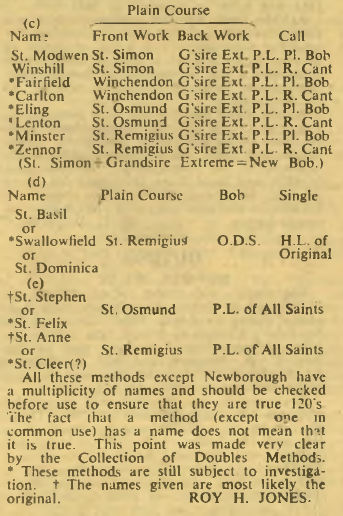
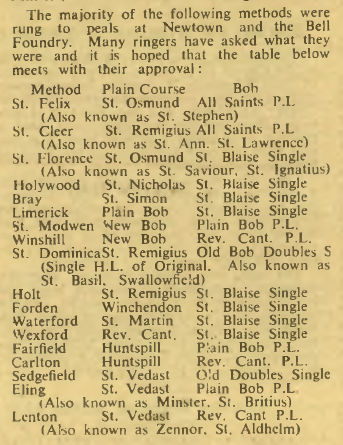
![]()
However it is not listed in the CC Doubles Collection (1980) and was subsequently named as Graduand (at Fawley in 1983 - RW p. 627).
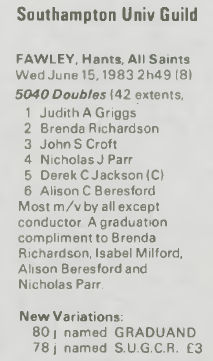
Meanwhile the name Eling was given in 1971 to 80je, that is St Vedast with an Old Hudibras Single, rung at Catherington (RW p. 550).
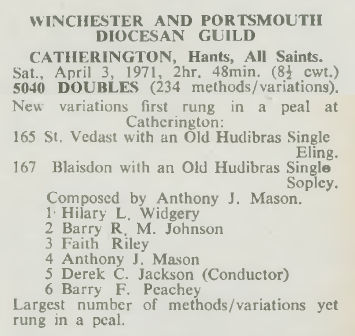
Both 80j and 80je are given as Eling in the printed Hiller collection, although in his electronic version, 80j has been changed to Graduand. Although 80j is clearly the older naming, perhaps for simplicity (and to avoid having to find another name for 80je) it's best to go with Graduand here?
Wolf
86uv - Union Bob with a New Grandsire Plain
This is given in the Dodd-Jones collection (RW 1966 p. 263), although in Section D, which contained variations about which there was some doubt.
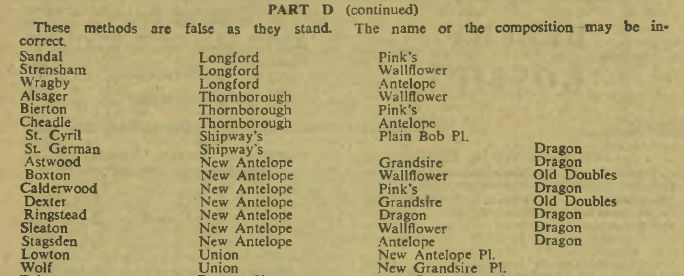
It was subsequently named as Akeman Street at Lichfield in 1992 (RW pp. 343 and 438).
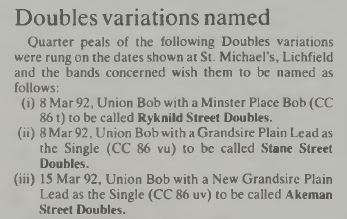
Kirkby
91m - St Augustine Bob with a Shipway Plain
This was rung in a peal at Blackwell in 1965 (RW pp. 299 and 342).

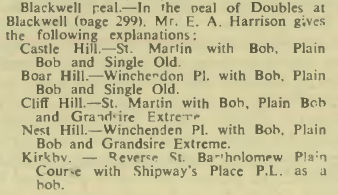
But it appears in the Dodd-Jones collection (RW 1966 p. 183) as Kirby.
![]()
It is not shown in the CC Doubles Collection (1980) and was subsequently named as Herm (at Laverstoke in 1982 - RW p. 931).

NB Herm II was named in January 2020, to replace Herm.

St Alkmund and St Denys
100c - Shipway Place with a Grandsire Single
100f - Shipway Place with a Wallflower Single
These names date from 1964 (RW pp. 236 and 252 respectively) and appear in the Dodd-Jones collection (RW 1964 p. 545 - NB Bob and Single column titles are the wrong way round).
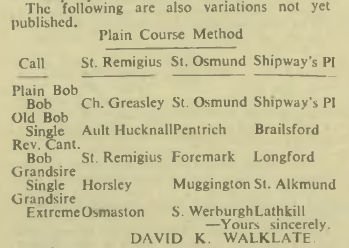
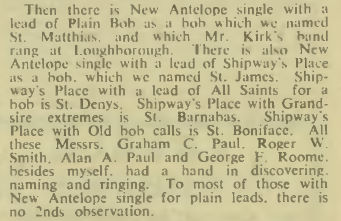

Both are shown as unnamed in the CC Doubles Collection (1980), but were then named as Great Somerford (at Great Somerford in 1984 - RW pp. 103 and 282)

and Ash Wednesday (at Chelford in 1984 - RW p. 293).
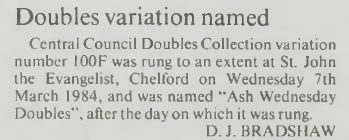
NB another variation was named Ash Wednesday in February 2020.
St Matthias and St Philip
122j - St James Bob with a Plain Bob Plain
122k - St James Bob with a Reverse Canterbury Plain
These are both mentioned in a letter in 1964 (RW p. 252), rung in peals at Loughborough (RW 1964 p. 163 - extent 12) and Grafton Underwood (RW 1963 p. 341).
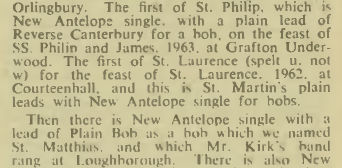
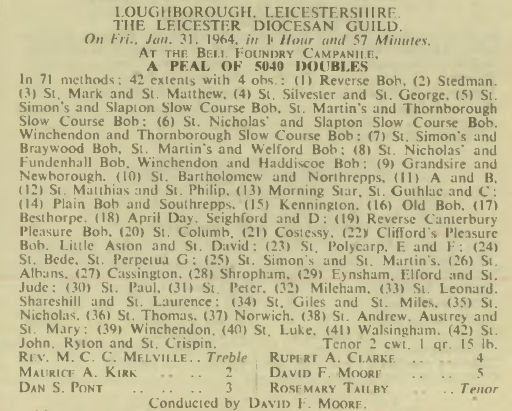
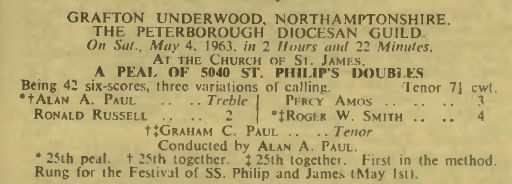
They appear in the Dodd-Jones collection (RW 1964 p. 545), but not in the CC Doubles Collection (1980).
![]()
Both methods were subsequently named in 1983 as Freefolk (at Longparish - RW p. 690)

and Canford (at Canford Magna - RW p. 688), respectively.
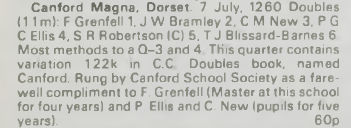
Note that the St James was previously known as Reverse St Sebastian. In the Appendix to the CC Doubles Collection (RW 1968 p. 575), the standard call is given as a Plain Bob Plain.
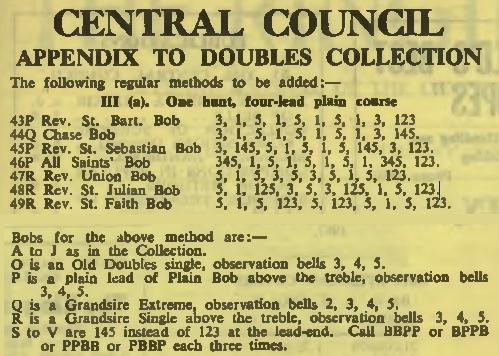
NB Freefolk II was named in October 2019.

Veryan and St Erme
103d - Blackburn Place with an Old Single
106d - Westminster II Bob with an Old Single
Both of these names appear in 1967 (RW p. 654), in a letter resulting from the variations being given alternative names in the Staunton-on-Wye peal mentioned above. The history of naming of Doubles variations contains many instances of names only appearing after a subsequent name is published.
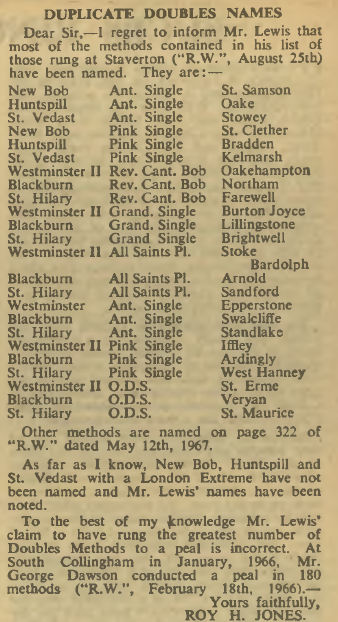
Neither appear in the 1980 CC Collection and were later named St Xystus and St Ursula (at Pevensey in 1986 - RW pp. 320 and 377).

Rushall
153j - All Saints Place with a Plain Bob Plain
This was the subject of debate back in 1953, with letters in the Ringing World (pp. 187, 219, 235 and 283), concluding that it should be Rushall.
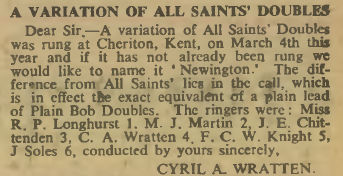
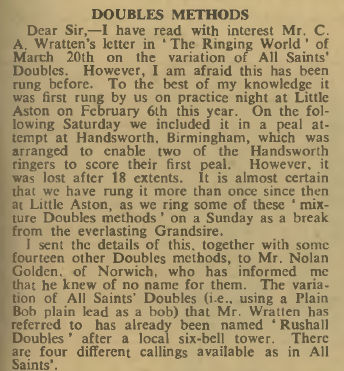
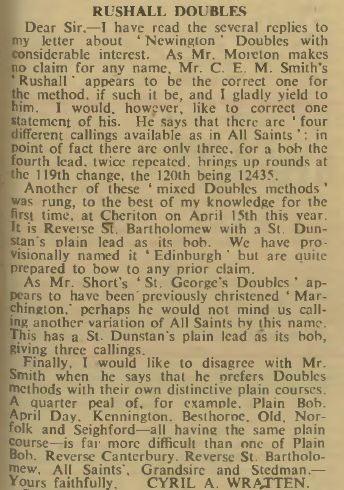
It appears as such in the Dodd-Jones collection (RW 1964 p. 545), but as Newington in the 1980 CC Collection.
![]()
Brookfield
169m - Minster Place with a Shipway Plain
This appears in the Dodd-Jones collection (RW 1966 p. 183), but unlike Abbots Ann (169k), which is also listed there, it doesn't appear in the CC Doubles Collection (1980).

It was subsequently named Mary Rose, being rung at Laverstoke in 1982 (RW p. 951).

Warmley
13b/d - St Osmund Bob with a Plain Bob Bob and an Old Single
These were formerly standard calls for St Osmund. The name Warmley goes back to 1966, being rung in a peal at Warmley (RW p. 265 - extent 6).
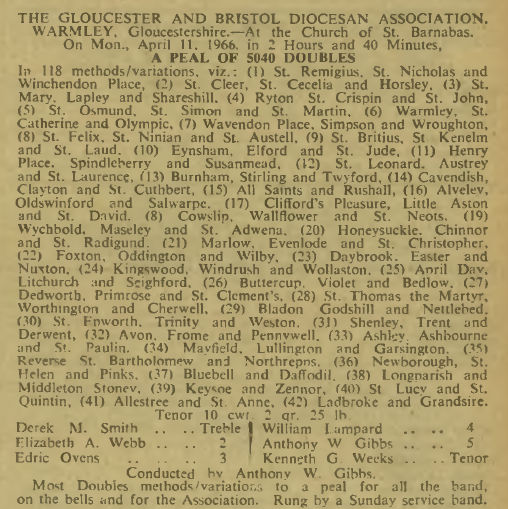
However, the definition of the variation doesn't seem to have come to light until it was rung as Shotesham (at Norwich in 1975 - RW p. 748).
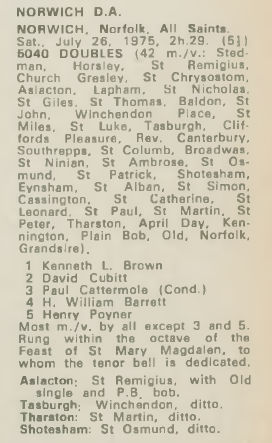
A letter in 1976 (RW p. 114) expounds the prior claim.
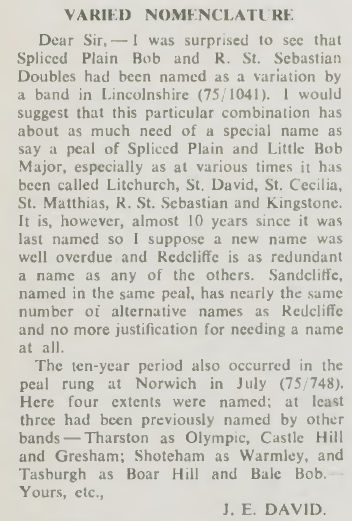
Hinksea
4je/dc - St Martin's Bob with an Old Hudibras Single as a Bob and a London Single
This appears in the original Dodd-Jones collection (RW 1964 p. 530) as Westminster, with the calling given as SBSPx3, which is not true. It is listed in section D, which was for variations about which there was some doubt.

In the Dodd-Jones supplement (RW 1966 p. 215), it is given as Hinksea, which would suggest that this was later, more accurate, information. However, no 120 is possible.
![]()
Callingwood
182w/br - Newark Place with a Wallflower Bob and a Burton Bob
This was rung in a quarter peal at Burton on Trent in 1995. The quarter peal report (RW p. 360) gives the name as Callingford, but the letter giving details (RW p. 455) gives Callingwood. However, the other variation named just before it in the letter is Rangemoor, which is a village in Staffordshire, half a mile from Callingwood, so I think the letter is correct.


Lawtonshill
H188y/dc - New Grandsire with a Pink's Bob and a London Single
This is listed in the Dodd-Jones collection (RW 1964) as both Lawtonshill (p. 183) and Westminster (p. 215), both in the same section.
![]()
![]()
No 120 is known; when this fact is mentioned in the CC Doubles Collection Appendix (RW 1969 p. 260), the name is given as Lawtonshill, so I am taking this one as the correct name.

Rempstone
H190w/g - New Newark with a Wallflower Bob and an Antelope Single
This appears as Kempstone (peal report, RW 1965 p. 888, extent 7), Kempston (peal report, RW 1967 p. 117, second line from bottom), Remstone (Appendix to CC Doubles Collection, RW 1968 p. 739) and Rempstone (Hiller collection). I don't know which is correct, but note that Rempstone is a place in Nottinghamshire, as are also Gedling and Kinoulton, which are other variations of New Newark using a Wallflower Bob.
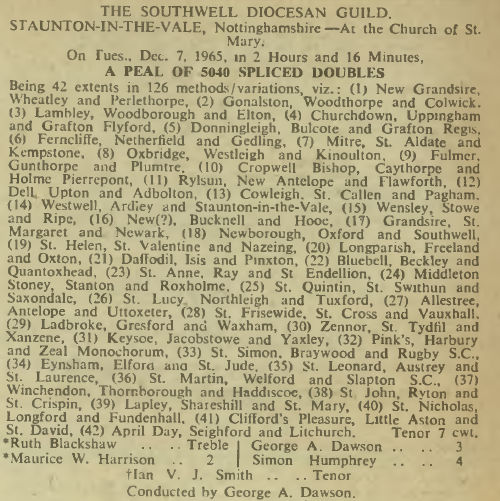
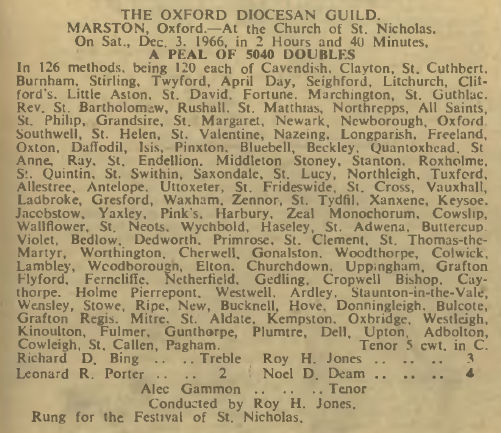
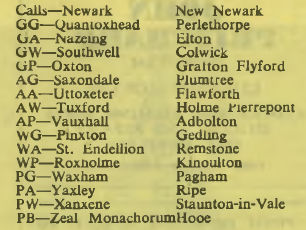
St Breward
80c - St Vedast Bob with a Grandsire Single
This first appears in a letter from Roy Jones in 1967 (RW p. 322), which reads "S. Breward", then in letters later in the year (RW pp. 634 and 674) as "St. Breward", presumably from the place name in Cornwall.
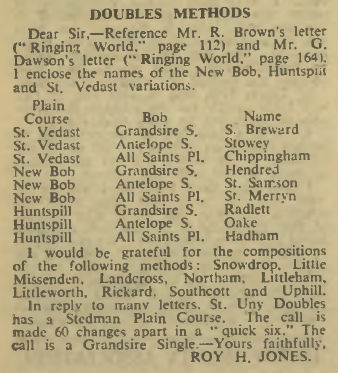
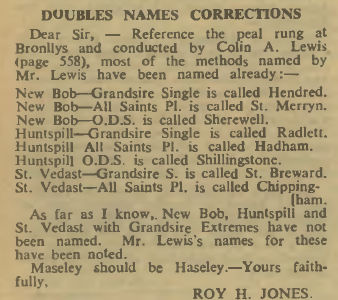
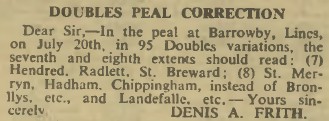
But then in 1968 it appears in the Appendix to C. C. Doubles Collection (RW p. 575) as "S. Brewood" and subsequently during the year as "St. Brewood" (e.g. peal at Eaton, RW p. 714, line 17).

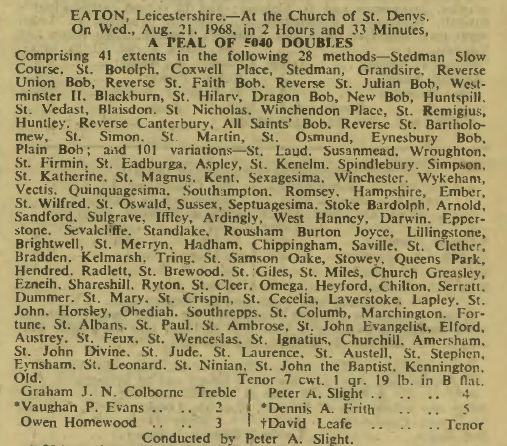
The name South Brewood appears in a peal in 1978 (RW p. 421) and is then used in the Hiller collection.
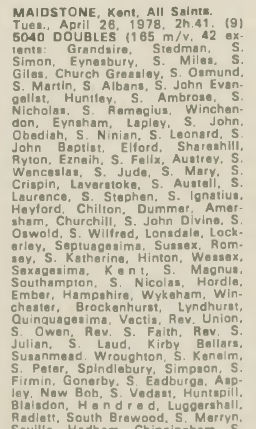
The variation doesn't appear (named or unnamed) in the 1980 C. C. Doubles Collection.
St Non
179x/g - Reverse Grandsire with an Antelope Bob and an Antelope Single
This was first rung in a peal at Litlington in 1968 (RW pp. 227 and 231), where it appears as "St. Non", presumably after the Welsh saint.
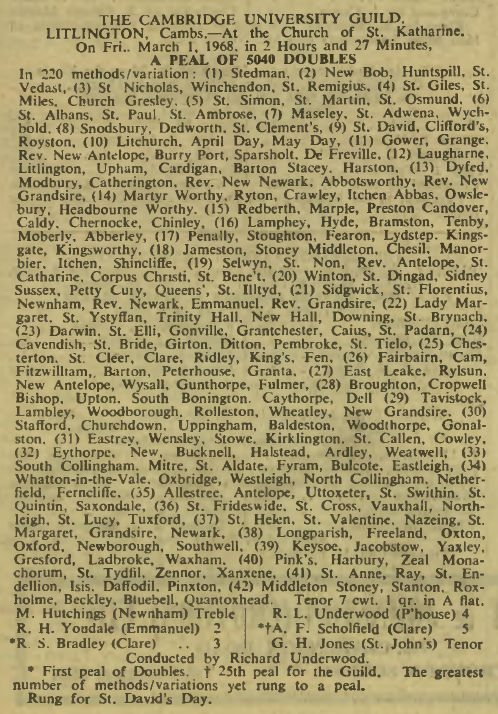
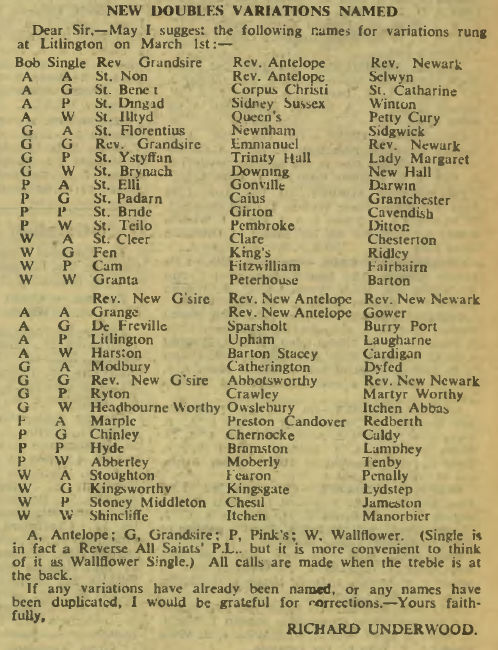
Other variations in the peal are also named after Welsh saints. However in the Appendix to Central Council Doubles Collection (RW 1968 p. 739) it is given as "St. Nom" and this name seems to have been used erroneously by Hiller.
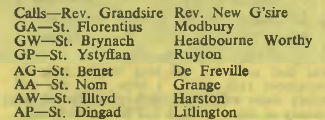
Camelford
180w/vw* - Antelope with a Wallflower Bob and a Barons Court Single
Extents of this were first rung at Church Gresley on 16 July 1988 (RW p. 744).
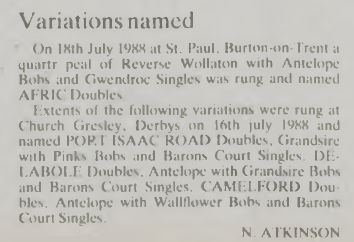
But when a quarter peal was rung on 16 August (RW 1988 pp. 922 and 995), it was described as using Pink's Bobs.
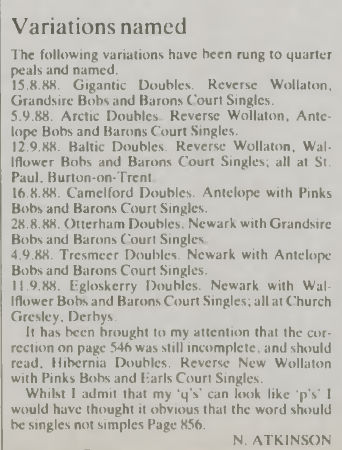

However this variation (180y/vw*) had already been rung at Church Gresley on 19 July (RW 1988 pp. 745 and 763), as Armada Beacon.


St Meriadoc / St Derwa
131b/p - Reverse Canterbury with a Plain Bob Bob and a Wainfleet Extreme
An extent of this variation rung at Tuckingmill in 2000 (RW p. 731), with the name given as St Meriadoc, but when a quarter peal was rung there in 2002 (RW p. 300), the name was given as St Derwa.
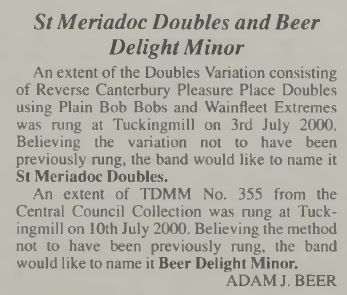

Also, St Derwa was rung in a quarter at Tuckingmill on 8 Jan 2001 (RW p. 388, but without variation names), which, judging by the other variations included (1b/p, 131b/q and 1b/q, among others), was 131b/p.
St Meriadoc had also been named in 1971 (RW p. 107, W14) as 184u/zv* (Wollaton with a Grandsire Bob and a Gwendroc Single), so perhaps that is why 131b/p was renamed? Unfortunately, the conductor, Adam Beer, has no recollection of this, but he is happy with 131b/p being St Derwa.
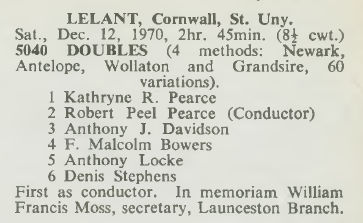
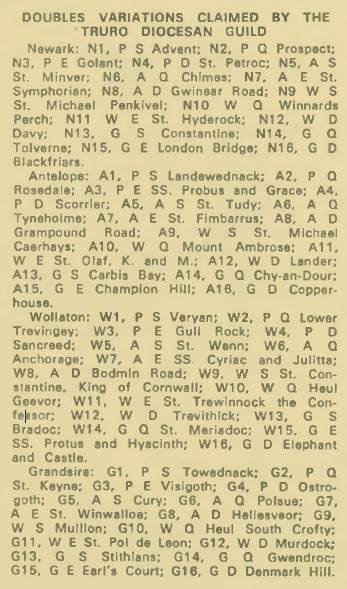
Taylor's / Flat Rod
137t* - St Nicholas with a New Roskear Single
7h* - St Simon with New Roskear Bob
An extent of 137t* was rung as Taylor's at Lelant in 2001 (RW pp. 721 and 820), but was rung in a quarter peal at St Erth (RW 2001 p. 808) and named as Flat Rod.
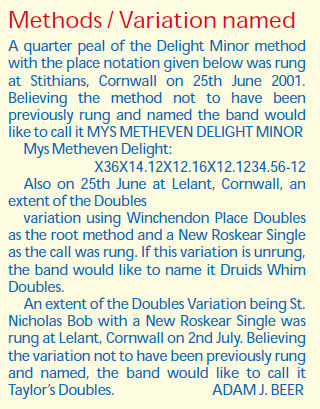
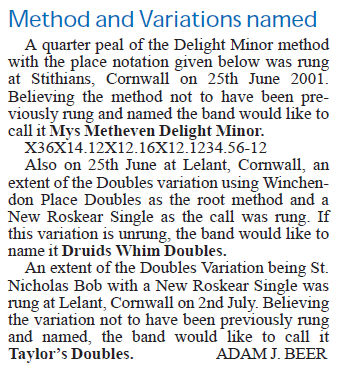
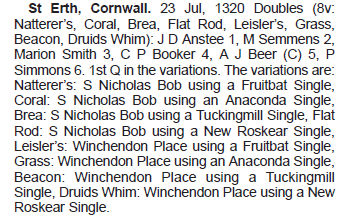
7h* was rung in a quarter at Tuckingmill in 2002 (RW p. 148) and named as Flat Rod.
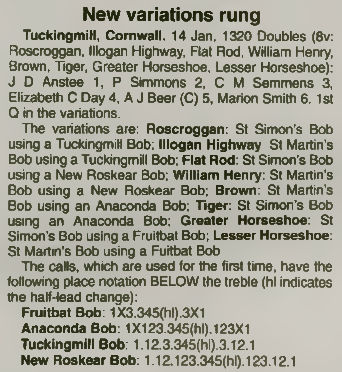
Again Adam Beer is unable to shed any light on this, but the simplest solution is that the name on page 808 is incorrect.
Swalcliffe
103g - Blackburn Place with an Antelope Single
This is given as Swalcliffe in a peal at North Muskham in 1965 (RW p. 805, extent 3), presumably named after the Oxfordshire village.
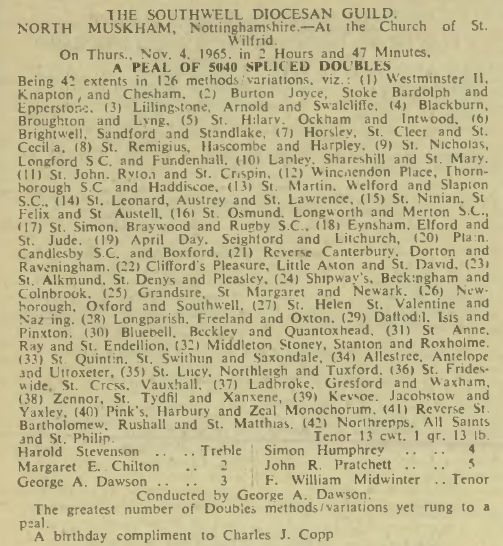
The same name is also used in a peal at South Collingham in 1966 (RW p. 122, extent 7).
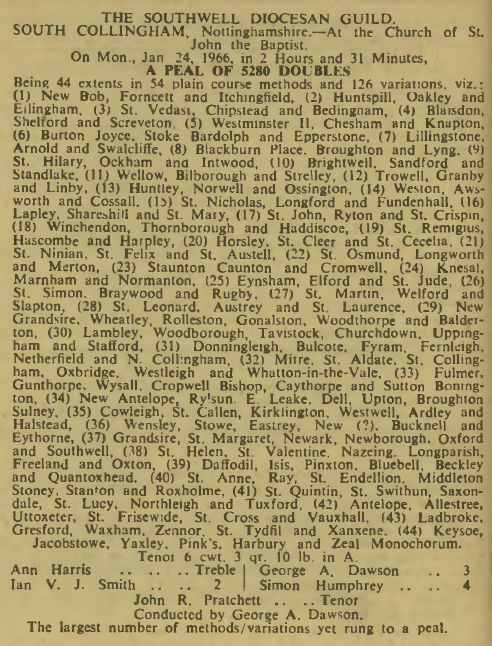
But when the conductor, George Dawson, writes to the Ringing World in 1967 (pp. 164 and 654), he gives the name as Sevalcliffe.
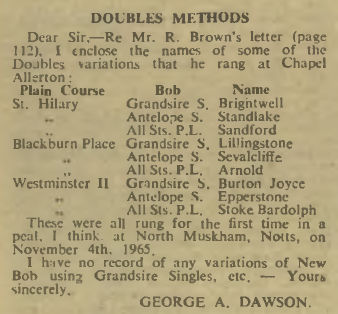
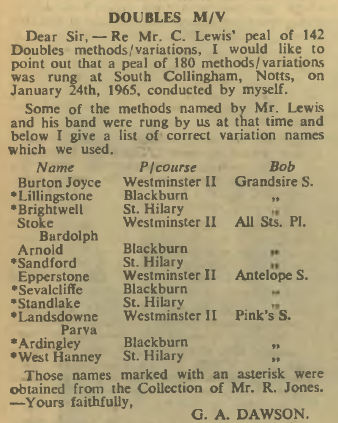
However, another on the same page (RW 1967 p. 654) from Roy Jones gives the name as Swalcliffe.

It appears in the CC Doubles Collection in 1968 (RW p. 575) as Sevalcliffe.
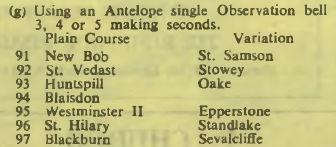
Oddly, although 103c, 103f and 103h are included, 103g doesn't appear in the CC 1980 Doubles Collection. In Hiller, it is given as Sevalcliffe.
Old Marston and Elsfield
100a/g - Shipway Place with a Reverse Canterbury Bob and an Antelope Single
100s/h - Shipway Place with a Shipway Bob and a Pink's Single
This is an example that has also occured with other variations. These variations were named as Rehanging and Ruby Wedding, respectively, at Lichfield in 1989 (RW p. 423).
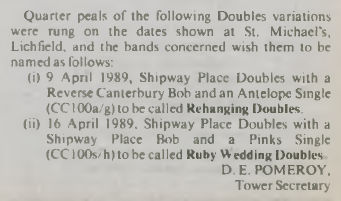
A letter was then written to the Ringing World (1989 p. 500), saying that these variations had been rung at Marston in the 1960s. I have found no earlier mention of the names, but assume the earlier ones have precedence.
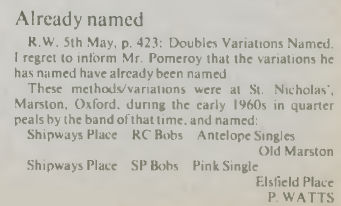
Canterbury
178u/a - Grandsire with a Grandsire Bob and a Reverse Canterbury Bob
This was described in 1969 in the CC Doubles Collection Appendix (RW p. 260), specifying it as a variation, to avoid confusion with the method, Canterbury Place.

It was rung at Basford in 2000 (RW 2000/1285 and 2001/16) and named Wilde.
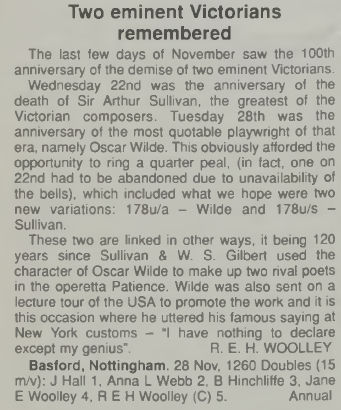
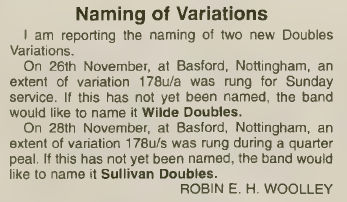
Thanks to David Mountford, who has pointed out that this variation was also rung as Ombersley, being rung in the quarter peal at Ombersley in 1978 (RW p. 1108) and in the peal there in 1979 (RW p. 663). The first reference to the name that I have found is in the quarter at Ombersley on 22 Jun 1979 (RW p. 625), but I haven't found any definition in the Ringing World.


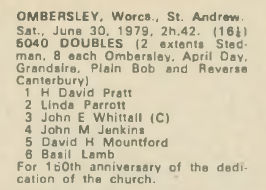
Radigund
131y/f - Reverse Canterbury with a Pink's Bob and a Wallflower Single
This is shown in the Dodd-Jones collection (RW 1966 p. 183) as Ragigund, but the spelling is changed in Hiller to (the more usual) Radigund. Is this a mistake being corrected or was Ragigund intended? I have found no earlier references to its origin.
![]()
Spindlebury
28g - Bampton Place with an Antelope Single
This is shown as Spindleberry in the Dodd-Jones Collection (RW 1966 p. 231). NB Henry Place is shown (RW 1966 p. 125); it had also been called Reverse St Faith, before becoming Bampton Place in the CC 1980 Doubles Collection.
![]()

But it appears as Spindlebury in the CC Doubles Collection Appendix (RW 1968 p. 575).
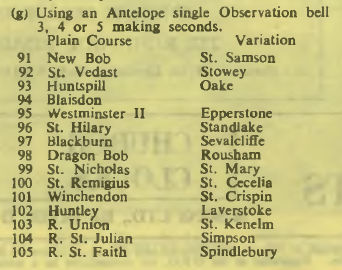
It has been used many times since then as Spindlebury and appears in the CC 1980 Doubles Collection as Spindlebury, so it should probably stay like that.
Butler, Barnsley, Ashchurch and Saintbury
These appear in the Dodd-Jones collection (RW 1966 p. 247) as variations of Reverse Canterbury using a Dragon Bob (later named as a Golden Bob) and, respectively, a Grandsire, Wallflower, Antelope or Pink's Single, but they are in Section D, containing variations about which there was some doubt.

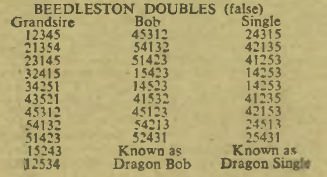
However, a letter to the Ringing World in 1989 (p. 540) claims that these variations used a Plain Bob plain lead for the Bob, rather than the Dragon Bob.
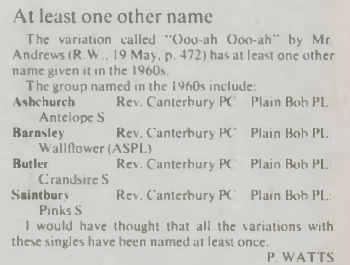
St Dunstan
This method originally appeared in Campanalogia in 1677. There it has a 2-lead plain course, with each lead being a Grandsire Bob. The calls are Grandsire Singles and Extremes. In the Dodd-Jones collection (RW 1964 p. 515), it uses London Singles (referred to there as London Extremes) and Grandsire Extremes.
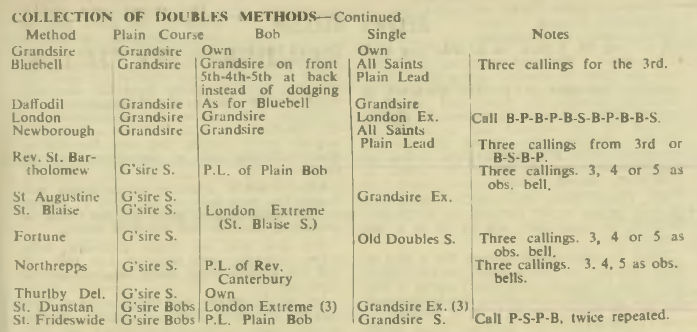
However the CC Collection in 1939 gives the Grandsire Extreme as the plain lead, again giving a 2-lead course, this time with three hunt bells. The calls are not specified. Its use seems to have been deprecated in the 1955 CC Collection, due to only having a 2-lead course, although it is shown in the Dodd-Jones collection in 1966 (RW p. 463), again with a Grandsire Extreme as the plain lead. Here the calls are Grandsire Bobs and Singles.

Following the removal in 2014 of the CC requirement that a method has more working bells than hunt bells, the method was rung to a quarter peal at Woolton Hill (RW 2014 p. 841), to formally name it again.
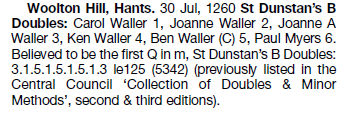
But St Dunstan has also been used, as described by Paul Cattermole in 1989 (RW p. 572), as Grandsire Doubles, rung with Bobs, Singles and Extremes. However, no 120 is possible. On the same page, Tony Smith discusses the historical variations in the naming.
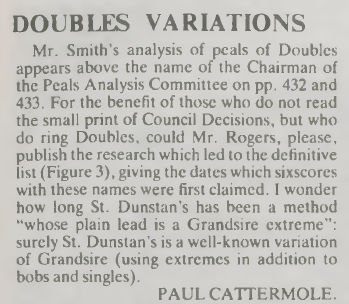
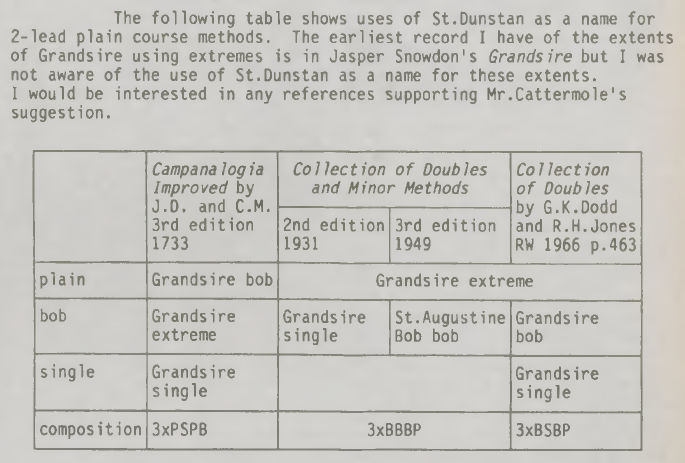
Eznieh
141b - Huntley Place with a Plain Bob Bob
This was rung in a peal at Upham in 1968 (RW p. 510), but the variations are not listed in the peal report. Its first appearance in print is in the CC Doubles Collection Appendix (RW 1968 p. 575), as Ezneih.
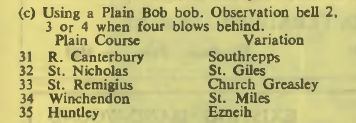
However a peal card from that first peal shows the name as Eznieh, apparently a play on "Heinz" (sixth line). It also appears under that name in a 1969 peal at Upham (RW p. 151).
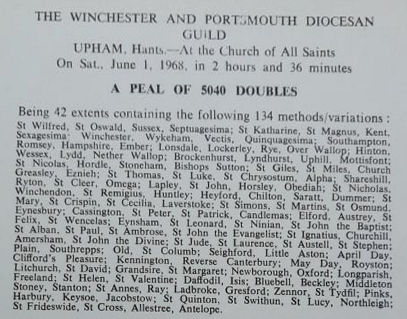
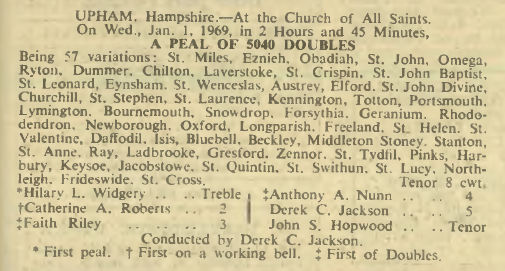
The 1980 CC Doubles Collection gives Ezneih.
Arley or Windsor
Lampton Place with a Plain Bob Plain and an Antelope Single
The only source for this is the Dodd-Jones Collection (RW 1966 p. 495), so we may never know which is the better name to use.
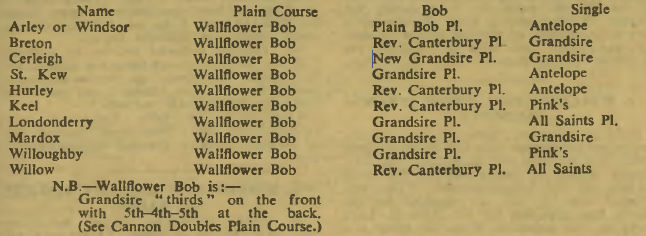
Zeus or St Cuthberga
153m - All Saints with a Shipway Plain
This was first rung as Zeus in a peal at Breadsall in 1965 (RW p. 550), but did not appear in the CC 1980 Doubles Collection. It was subsequently named as St Cuthberga (RW 1982 p. 409), under which name it appears in the Hiller collection. It was also claimed as Overton (RW 1982 p. 471) and Ashcott (RW 1984 p. 840).
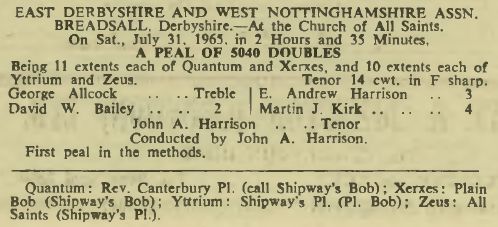
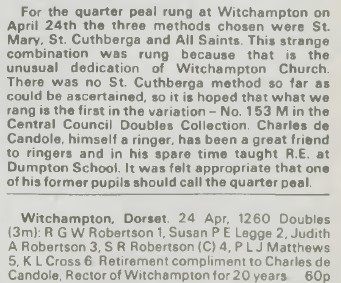
There are also a couple of other instances of queries about names in the appendix to the 1980 Doubles Collection, maintained by Tony Smith at http://www.methods.org.uk/other/douvars.htm.
St George's
122q - St James Bob with a Minster Extreme
This was originally rung at Didbrook on 23rd April 1988 (RW pp. 496 and 603).
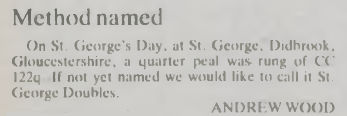

However, there was already a variation named St George, so it was amended in a correction to the CC 1980 Collection of Doubles Methods (RW 1989 pp. 32 and 174).

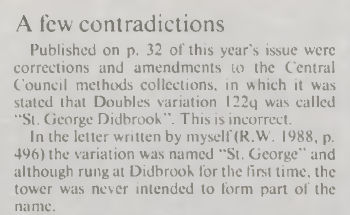
Andrew Wood later amended the name of the variation to St George's (RW 1989 p. 336).

St Cecelia
143g - St Remigius Bob with an Antelope Single
This appears as St Cecelia in the Dodd-Jones Collection (RW 1964 p. 545 - NB Bob and Single column titles are the wrong way round).
![]()
It is given in the CC Doubles Collection Appendix (RW 1968 p. 575) and in the CC 1980 Collection of Doubles Methods as St Cecilia.

Church Greasley
143b - St Remigius Bob with a Plain Bob Bob
This appears as Church Greasley in a letter from David Walklate (RW 1964 p. 236).

But it is then given as Church Gresley in the Dodd-Jones Collection (RW 1964 p. 545 - NB Bob and Single column titles are the wrong way round).
![]()
It appears in the Appendix to the CC Doubles Collection (RW 1968 p. 575) and CC 1980 Collection as Church Greasley.

These variations are ones for which Hiller explicitly gives a choice of names. Again, I have tried to work out which one is the oldest.
Hilmarton
1a/g - Plain Bob with a Reverse Canterbury Bob and an Antelope Single
Given as Hilmarton in the Dodd-Jones collection in 1964 (RW p. 514), but as Kingswood in the Dodd-Jones collection in 1966 (RW p. 183).
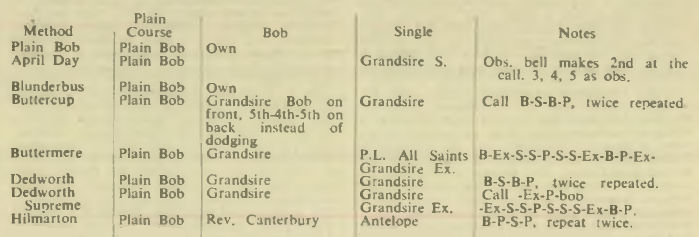

I've found no earlier sources for these names, so it's not clear which should have precedence. Normally, one tends to go for the earlier instance, but as the 1966 list is an update of the 1964 list, it might be expected to be more accurate. In 1966, Kingswood is in part B, given as a correction to part D (the less firmly known part of the list), although Hilmarton was in fact in section C in 1964. It was given as "Hilmorton [sic] or Kingswood" in the Hiller collection.
Olympic
4b/d - St Martin with a Plain Bob Bob and an Old Single
These were formerly standard calls for St Martin. It was first rung at Handsworth in 1964 (RW pp. 716 and 730) to mark the Tokyo Olympics, and given in the Dodd-Jones collection (RW 1966 p. 215).


![]()
I haven't found a reference to Hiller's alternative name of Thrapston, but the variation was rung as Tharston at Norwich in 1975 (RW p. 748).

It also appears as Castle Hill and Gresham in 1965 (RW pp. 299, 342 and 488).


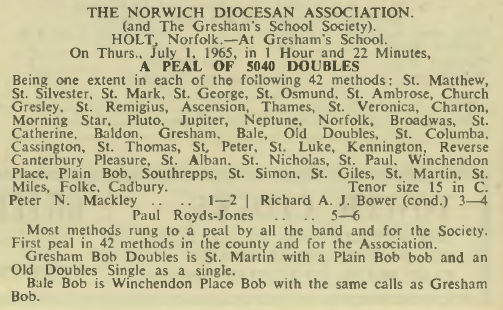
Barrington
69ej - Huntspill Bob with a Ready Money Single
This was rung at Wootton Courtenay in 1968 (RW pp. 839, 851).


Hiller gives Bovington as an alternative name, but I've found no reference for this.
Great Ponton
78r/f - Blaisdon Bob with a New Bob Bob and a Wallflower Single
Rung at Branston in 1968 (RW p. 893, third line from bottom), it was given in the Appendix to Central Council Doubles Collection (RW 1969 p. 80, number 388).
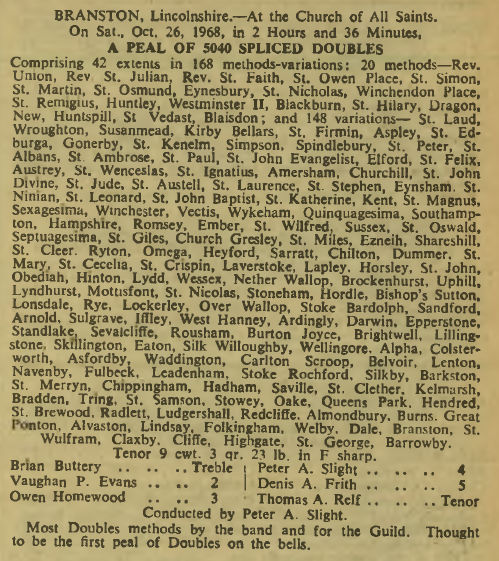
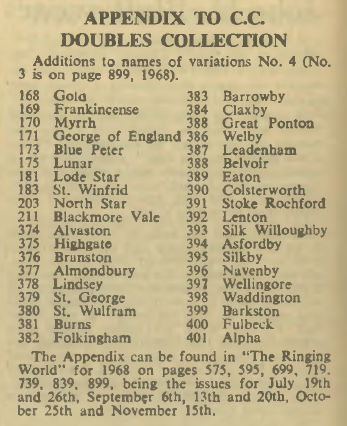
The name Stoke Abbot given by Hiller occurs in a peal at Maidstone in 1978 (RW p. 421, 19th row from bottom), in which Hiller rang.

Wendover
100h - Shipway Place with a Pink's Single
Given in the Dodd-Jones collection in 1966 as Wendover (RW p.215), this was not given in the 1980 CC collection.
![]()
Hiller gives Chalderford as an alternative name; this was rung at Chelford in 1984 (RW pp. 268 and 880).
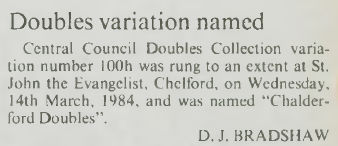
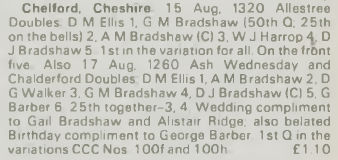
It was referred to, however, as Chelderford in a letter to the Ringing World in 1987 (p. 760).
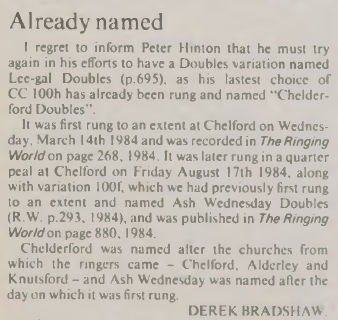
Broadwas
131b/d - Reverse Canterbury with a Plain Bob Bob and an Old Single
Rung in a peal at Broadwas in 1960 (RW pp. 653 and 656), this was shown in the Dodd-Jones collection in 1964 (RW p. 514).
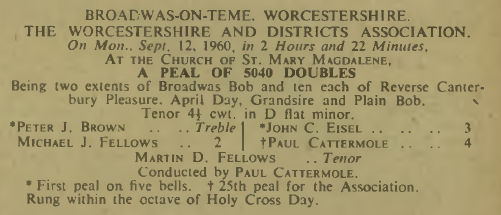


Hiller gives the alternative name Shardlow; the first reference I have found to this is a peal at Allestree in 1964 (RW p. 365).

Roy Jones writes in a letter to the Ringing World in 1965 (p. 344) that "Shardlow [is another name] for Broadwas".

The variation is given as Shardlow in the Appendix to Central Council Doubles Collection (RW 1968 p. 699).
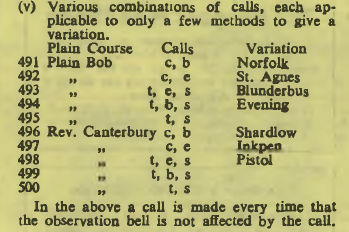
Dumbleton
131u/g - Reverse Canterbury with a Grandsire Bob and an Antelope Single
Rung in a quarter peal at Dumbleton in 1962 (RW p. 293), this was described as "Wychbold, with Antelope Singles instead of Grandsire Singles."

It appeared in the Dodd-Jones collection in 1964 (RW p. 514).
![]()
Hiller gives the alternative name Maseley, which comes from the 1966 Dodd-Jones collection (p. 183), but Roy Jones writes in a letter (RW 1967 p. 634) that "Maseley should be Haseley".
![]()

Lockerley
134a/c - Winchendon Place with a Reverse Canterbury Bob and a Grandsire Single
Rung in a peal at Upham in 1968 (RW pp. 510 and 595).
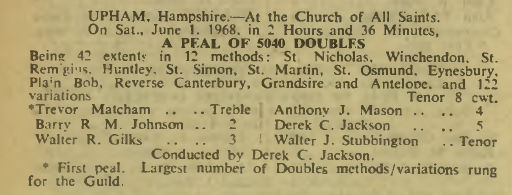
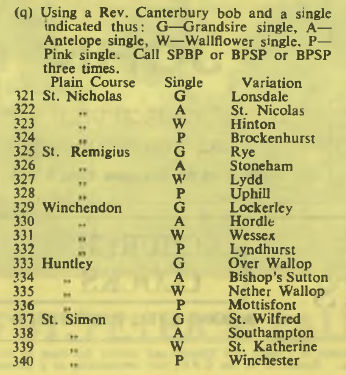
![]()
Hiller gives the alternative name Lakenham, which first appears in a peal at Norwich in 1975 (RW 1976 p. 72).
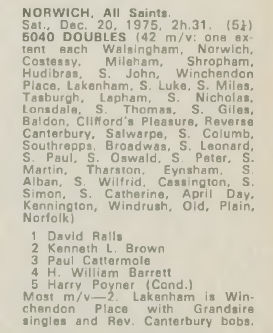
Boar Hill
134b/d - Winchendon Place with a Plain Bob Bob and an Old Single
Rung in a peal at Blackwell in 1965 (RW pp. 299 and 342), this appeared in the Dodd-Jones collection in 1966 (RW p. 215).


![]()
Hiller also gives the name Tasburgh, which comes from another 1975 peal at Norwich (RW p. 748).

The previous naming was pointed out in a letter from J. E. David (RW 1976 p. 114).

Magdalen
4e - St Martin with a Grandsire Extreme
This was rung as Magdalen in a peal at Old Marston in 1948 (RW p. 328) and as Mileham in a peal at Roade in 1952 (RW1953 p. 37).
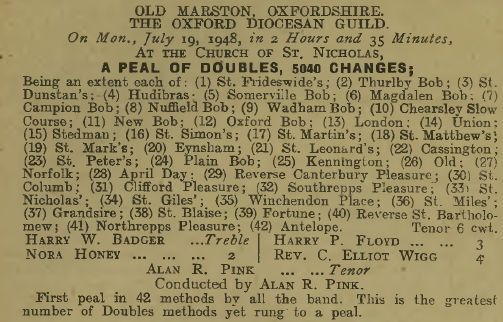
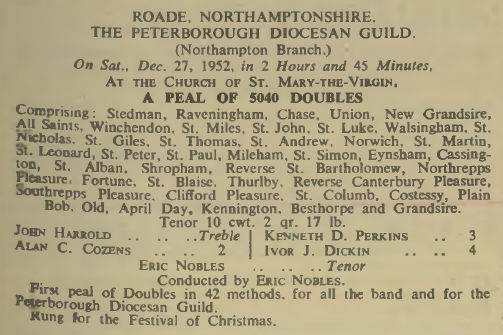
This led to letters to the Ringing World in 1953 (pages 315, 348 and 399).
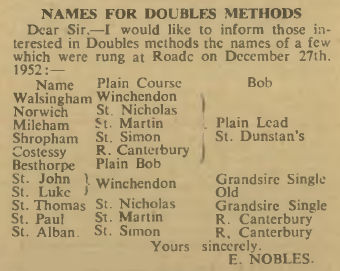
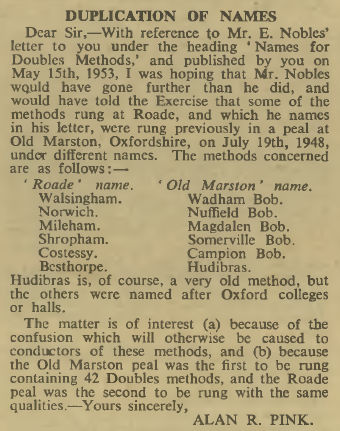
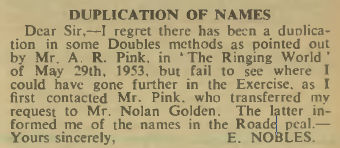
It appears in the CC 1980 Doubles Collection as Magdalen, but Hiller also gives the name Mileham.
Somerville, Wadham and Nuffield
7e, 134e and 137e; St Simon, Winchendon and St Nicholas, each with a Grandsire Extreme
These each have the same story as Magdalen, being given the names Shropham, Walsingham and Norwich, respectively, in the Roade peal. Again, the 1948 names are given in the CC 1980 Doubles Collection, and it seems clear that these names have precedence, but the 1952 names should also be recorded.
Donningleigh
H188w/c - New Grandsire with a Wallflower Bob and a Grandsire Single
The first mention I've found of this variation is in a letter correcting names used in a peal at Cropwell Bishop in 1965 (RW pp. 367 and 392).
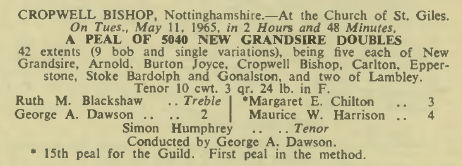
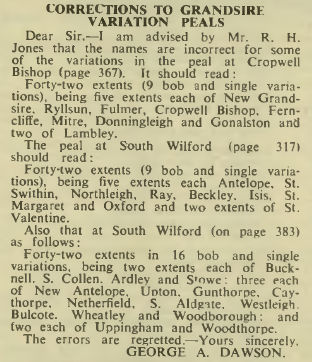
It is also given in the Appendix to the CC Doubles Collection (RW 1968 p. 739).
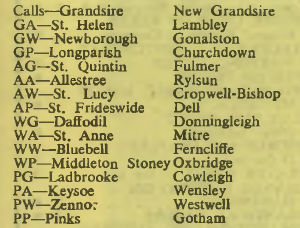
However, in the Dodd-Jones collection (RW 1966 p. 183) it is given as Eastleigh, which is odd given that Roy Jones is mentioned as the source of the information behind the letter in 1965.
![]()
St Callen
H189y/c - New Antelope with a Pink's Bob and a Grandsire Single
Like Donningleigh, this is given in the letter of correction of names (RW 1965 p. 392), but this time for a peal at South Wilford (RW p. 382, not 383 as stated in letter), as St Collen.
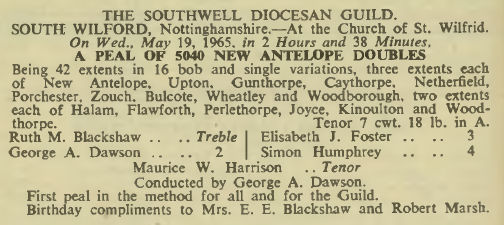

It is shown in a peal at Staunton-in-the-Vale (RW 1965 p. 888, extent 13) as St Callen.

It appears as St Callen in the Appendix to the CC Doubles Collection (RW 1968 p. 739).
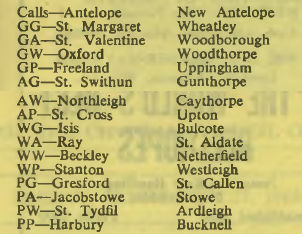
However, St Collen is a more well-known saint, to whom Llangollen church is dedicated. Hiller also gives the name Berkeley as an alternative, which appears in the Dodd-Jones collection (RW 1966 p. 215).
![]()
Woodthorpe
H189u/f - New Antelope with a Grandsire Bob and a Wallflower Single
This first appears as Woodthorpe in a peal at South Wilford in 1965 (RW p. 382).

It is given as Carswell in the Dodd-Jones collection (RW 1966 p. 215) and this name is given as an alternative in the Hiller Collection.
![]()
It appears as Woodthorpe in the Appendix to the CC Doubles Collection (RW 1968 p. 739).

St Aldate and Westleigh
H189w/g - New Antelope with a Wallflower Bob and an Antelope Single
H189w/h - New Antelope with a Wallflower Bob and an Pink's Single
These two appear as Porchester and Zouch, respectively, in a peal at South Wilford in 1965 (RW p. 382).

The names are corrected to St Aldate and Westleigh in a letter from George Dawson (RW 1965 p. 392).

They appear as Porchester and Zouch in the Dodd-Jones collection (RW 1966 pp. 215 and 231).
![]()
![]()
Then they are shown as St Aldate and Westleigh in the Appendix to the CC Doubles Collection (RW 1968 p. 739).

These cases come from where the same variation has been given two separate names in the Ringing World. As most of them were rung by much the same bands, I believe that, for whatever reason, what appears in the Ringing World is incorrect. Judging by the order of the sets of names in the Ringing World, I suggest the following corrections:
| Name | Correction | Printed as | RW Page Reference | Notes |
|---|---|---|---|---|
| Stefan | 1u/f/g/p/q/k | 1u/c/g/p/q/k | 1994 p. 860 | |
| Lydden | 100w/f/h/q | 100w/f/g/q | 1995 p.646 | |
| Ermintrude | 1st/c/f/g/h | 131st/c/f/g/h | 1993 p. 1155 | NB. the textual description refers to Plain Bob |
| Katmai | 131u/c/h/p/q/j | 131u/c/g/p/q/j | 1995 p. 450 | |
| Donizetti | 131w/c/f/h/q | 131w/c/f/h/d | 1994 p. 1174 | |
| Paganini | 131w/c/g/q | 131w/c/g/d | 1994 p. 1174 | |
| Schumann | 131w/f/g/q | 131w/f/g/d | 1994 p. 1174 | |
| Offenbach | 131w/f/g/h/q | 131w/f/g/h/d | 1994 p. 1174 | |
| Boccherini | 131w/g/h/q | 131w/g/h/d | 1994 p. 1174 | |
| Descapezado | 131w/c/f/h/q/j | 131w/c/f/h/e/j | 1995 p. 450 | |
| Aconcagua | 131w/c/g/q/j | 131w/c/g/e/j | 1995 p. 450 | |
| Beerenberg | 131w/f/g/q/j | 131w/f/g/e/j | 1995 p. 450 | |
| Fujiyama | 131w/f/g/h/q/j | 131w/f/g/h/e/j | 1995 p. 450 | |
| Tupungato | 131w/g/h/q/j | 131w/g/h/e/j | 1995 p. 450 |